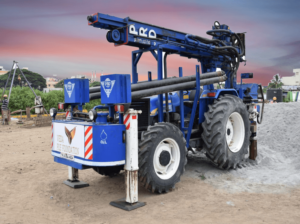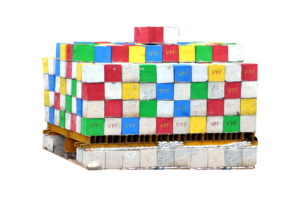Pile Foundation contractors in Mumbai
BORED CAST IN SITU PILE IN MUMBAI
Tractor Mounted Hydraulic Rotary Rig (Direct Mud Circulation Method)
 The system is very useful in congested areas where noise is prohibited.
The system is very useful in congested areas where noise is prohibited.- Here the bore is made by drilling the ground using a Tractor Mounted Hydraulic Rotary rig.
- The boring is done with the raimmer which has provision for sending bentonite solution under pressure.
- The bored muck is carried to the sur face by the circulating bentonite (So it is called direct mud circulation system) Once the hard strata is reached socketing will be done if required.
- The stratum for termination is identified by conducting Standard Penetration Test.
- Once the boring is complete the borehole is washed by circulating fresh water continuously.
- The specific gravity of the out flow solution is measured using hydrometer to ensure that the bore is properly cleaned.
- Then the reinforcement is lowered followed by tremmie and the concreting is done
DRIVEN CAST IN-SITU PILE IN MUMBAI
MAX DIA 600MM [ IS 2911 PART(1) SEC(1) ]
- Driven piles are installed by driving a casing pipe.
- The soil investigation reports are based on the N-value.
- The casing pipe is driven by single acting drop hammer with the required height of fall.
- This is determined by the state of compaction of the soil strata.
- Soil investigation report based on the N-value also decides this.
- Casing reaches the hard strata beyond which the rate of penetration is very small, concrete is poured with the help of chute cart, and the casing is extracted progressively, simultaneously tamping the tube as the tube is extracted.
As the name suggests, driven piles are installed by driving a casing pipe whose outer diameter represents the nominal diameter of the pile. The casing pipe is driven by a single-acting drop hammer with the required height of fall determined by the state of compaction of the soil strata. This is obtained from the soil investigation report based on the N-value. Once the casing reaches the hard strata beyond which the rate of penetration is very small (This is termed as set. The set is defined as the penetration for a given number of blows; say for example this can be 10mm for the final 10 blows) concrete is poured with the help of chute cart, and the casing is extracted progressively, simultaneously tamping the tube as the tube is extracted.
The three main advantages are:
- The state of compaction is assessed as the tube is driven by observing the number of blows required for a constant depth of penetration
- The energy imparted to the soil by driving the tube compacts the surrounding soil which helps in the increase of friction capacity of the pile
- The tamping of the tube while extraction creates serrations in the pile shaft which ensures the mobilization of the shaft friction.
PRE-CAST DRIVEN CONCRETE PILE IN MUMBAI
MAX SIZE 500 MM X 500MM [ (IS 2911 PART (1) SEC (3) ]
- The piles are cast in a specially made platform/casting yard.
- These square shaped piles are of maximum 500mm X 500mm size.
- Sometime octagonal in shape.
- The pile is driven to a set using drop hammer.
- All the advantages of driven cast in situ pile are available in this case also.
In the case of pre-cast driven pile, the pile is cast in a specially made platform/casting yard The pile is generally square shaped up to a maximum size 500mm X 500mm. Occasionally octagonal shape is also used. Well-designed casting and stacking arrangements are practiced at site. The pile is driven to a set using drop hammer selected based on the size, pile weight and capacity requirement All the advantages of driven cast in situ pile are available in this case also.

OUR STRATEGIC SUSTAINABILITY
Precast Concrete Pile may be defined as a reinforced concrete pile which is moulded in circular, square, rectangular or octagonal form. The precast concrete pile are cast and cured in a casting yard and then transported to the site for driving. In case space is available, pile can also be cast and cured near the site of works. They are driven in a similar manner as timber pile with the help of pile drivers. The diameter of the pile normally varies 35cm to 50 cm and their length varies from 45 in to 30 m.
Contiguous Pile in Mumbai
Contiguous pile walls consist of piles arranged in a line typically with a 150mm gap between the piles. Where required the soil between the piles can be stabilized using grouting techniques if necessary, either before or after pile installation.
Common uses
- Support of excavations
- Slope stabilisation
- Support wing walls
Process
Contiguous pile walls can be retained by anchors or strutting systems to reduce deflection though commonly for walls up to 7-8 metres in height they are designed to work in cantilever.
Advantages
- Limited load from surrounding structures taken
- Allows easier work in open excavations when in cantilever
Quality assurance
We use the latest technology, testing regimes and best practice protocols developed over many years to ensure the position, verticality and structural integrity of our pile walls.
PILE LOAD TEST IN MUMBAI
IS 2911 PART (IV)
AXIAL COMPRESSION TEST WITH KENTLEDGE BLOCKS
 Pile load test shall be performed when concrete has reached its required strength i.e. 28 days
Pile load test shall be performed when concrete has reached its required strength i.e. 28 days- The axial compressive loads test should be done as per IS code 2911 part IV
- The dead weight to be applied shall be 25% more than the maximum jacking force required.
- Pile Loading Test shall be performed by applying compression load to the pile top by means of a hydraulic jack.
- The settlement shall be recorded by suitably positioned dial gauges.
- The Kent ledge consisting of frame capable of providing reaction shall be used.
- The C.G. of Kent ledge should be on the axis of the pile and the load applied by the jack should be co-axial with the pile
Micro Pile in Mumbai
Micro piles, also known as mini piles, pin piles, needle piles, and root piles, are deep foundation elements constructed using high-strength, small-diameter steel casing and/or threaded bars.
Common uses
- Provide structural support to most structures
- Underpin foundations
- Enhance mass stability
- Transfer loads
The micro pile casing generally has a diameter in the range of 3 to 10 inches. Typically, the casing is advanced to the design depth using a drilling technique. Reinforcing steel, typically an all-thread bar is inserted into the casing. High-strength cement grout is then pumped into the casing. The casing may extend to the full depth or end above the bond zone with the reinforcing bar extending to the full depth.
This technique has been used to support most types of structures. Veda’s micro pile drill rigs allow installation in restricted access and low headroom interiors, allowing facility upgrades with minimal disruption to normal operations.
Veda can combine our micro pile technology with one or more of our other ground modification techniques to meet unique or complex project requirements cost-effectively and efficiently. Lines of micro piles spanned by wooden lagging can be ideal where excavation walls are required in low headroom and other confined areas. Post-grouting within the bond length can increase frictional forces with surrounding soils and achieve greater capacity. Micro piles can serve to “stitch” the soil together within predicted shear zones to enhance mass stability. In liquefiable profiles, micro piles can transfer loads to competent bearing strata to follow seismic design requirements.
- Resists compressive, uplift/tension, and lateral loads
- Comprehensive fleet of rigs and tooling for difficult subsurface conditions and limited access
- May avoid utility re-routing
- Alleviates quality assurance concerns associated with cast-in-place piling in weak soils
- Can be combined with other techniques to meet unique or complex project requirements cost-effectively and efficiently
Quality Assurance
The finished micro pile (mini pile) resists compressive, uplift/tension, and lateral loads and is typically load-tested following ASTM D 1143 (compressive), ASTM D 3689 (uplift/tension), and ASTM D 3966 (lateral). Capacities vary depending on the micro pile size and subsurface profile. Allowable compressive capacities of more than 500 tons have been achieved.
Our Service Areas
- Pile Foundation contractors in Andheri
- Pile Foundation contractors in Bandra
- Pile Foundation contractors in Borivali
- Pile Foundation contractors in Dahisar
- Pile Foundation contractors in Dharavi
- Pile Foundation contractors in Goregaon
- Pile Foundation contractors in Jogeshwari
- Pile Foundation contractors in Kandivali
- Pile Foundation contractors in Khar
- Pile Foundation contractors in Malad
- Pile Foundation contractors in Parel
- Pile Foundation contractors in Santacruz
- Pile Foundation contractors in Vile Parle
- Pile Foundation contractors in Ghatkopar
- Pile Foundation contractors in Kurla
- Pile Foundation contractors in Mulund
- Pile Foundation contractors in Pawai
- Pile Foundation contractors in Vidyavihar
- Pile Foundation contractors in Vikhroli
- Pile Foundation contractors in Chembur
- Pile Foundation contractors in Mankhurd
- Pile Foundation contractors in Tardeo
- Pile Foundation contractors in Govandi
- Pile Foundation contractors in Wadala
- Pile Foundation contractors in Trombay
- Pile Foundation contractors in Bhuleshwar
- Pile Foundation contractors in Byculla
- Pile Foundation contractors in Dadar
- Pile Foundation contractors in Fort
- Pile Foundation contractors in Girgaon
- Pile Foundation contractors in Kalbadevi
- Pile Foundation contractors in Kamathipura
- Pile Foundation contractors in Matunga




